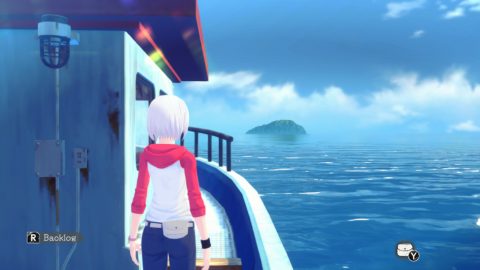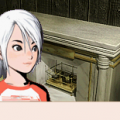- Trace Memory
- Another Code: R – A Journey Into Lost Memories
- Another Code: Recollection
Although Nintendo retained the rights to Another Code (along with the Hotel Dusk games), the series wouldn’t see a new installment of sorts until early 2024. Another Code: Recollection aims to remake the series from the ground up, using the same storylines but with entirely new gameplay and plot tweaks to integrate them more seamlessly.
Unlike plenty of game remakes, Recollection features key members of the originals’ staff working alongside Arc System Works. These include Rika Suzuki returning to supervise the game design and scenario, Taisuke Kanasaki as character designer and art director, Takuya Miyagawa as technical director, and Satoshi Okubo helping to compose and arrange the game’s soundtrack.
This makes for a fascinating revisit of the Another Code series, one that doesn’t overwrite those games but creates an alternate experience which compliments them. For fans of the originals and newcomers looking to try more leisurely, character-driven adventure games, it’s worth a look.
Recollection is structured as a two-part campaign, beginning with Two Memories and transitioning into Journey into Lost Memories (similar to the various ports/remakes that combine Ys I & II into a single game). You can’t access the latter on its own; you have to play through the former every time or keep a spare save file handy. On that note, you’re still able to save anywhere if you’re not in a conversation, but the lack of a chapter select for replays is baffling.
Mechanically, it eschews the top-down and side-scrolling/limited view perspectives of the originals for a fully 3D third-person adventure where you can freely move around, talk to people and examine objects. The camera moves around very slowly, though this can be increased in the options menu. You can also turn on puzzle hints or a compass to show the way forward if you’re stuck, which are welcome additions alongside the ability to have the dialogue play automatically and a backlog to re-read (and even listen to) previously spoken dialogue.
The DAS has been redesigned to resemble a Switch, and it’s got some reworked features. You can now move around while using the DAS camera, and scan special paper origami cranes hidden in various areas. These cranes unlock journal entries by Ashley’s father Richard, where he muses about his daily life, thinks back to his past, or reports on things he’s been looking into. These are purely optional, but appreciated extras for those looking to get more invested.
On that note, the character/relationship chart from Another Code: R has been integrated into both games, and their descriptions now update as the plot develops. These are written from Ashley’s perspective, which helps you keep track of things and gives some nice insight into how she’s feeling. This is particularly important because Ashley no longer quizzes herself about what’s happened at the end of each chapter.
Although these sections could sometimes be a bit redundant, they complimented the games’ interest in memories in a tangibly active way and gave Ashley the space to process events. It’s perhaps the biggest change mechanically, and a subtle shift in the storytelling since Ashley generally has fewer moments of introspective monologuing.
Another Code‘s puzzles were designed around the many hardware gimmicks of the Nintendo DS and Wii, often to delightfully inventive results. But the Switch is a different system; one that can be played as a pure console, a pure handheld, or some mix of the two; and so Recollection features entirely new puzzles. Only two of them are based on the Switch’s capabilities, utilizing its gyroscopic tech while completely ignoring the touchscreen.
There are fewer puzzles overall compared to the originals, especially for the Journey into Lost Memories portion, but they each have a unique construction and solution. One puzzle has you exploring a darkened library and looking for the lights, while another requires taking pictures with the DAS’ camera to find the answer. There’s always something new to look forward to, whether you’re interested in puzzles or solving the mysteries behind each adventure.
Two Memories gets a largely faithful retelling, taking its tonal cues from the European translation of the original instead of the American localization for Trace Memory. Some events occur in a different order, a handful of minor details are either omitted or made more explicit, it creates a few connections to the sequel, and the overall pace is slower.
This is partially thanks to the cutscenes now featuring 3D character animations, similar to Another Code: R, and voice acting in both English and Japanese. The cutscenes are nicely animated and directed, with characters reacting to things through expressive movements and gestures. The voice acting manages to be convincing enough in either language, if occasionally hokey (the English dub also has an odd quirk where vocal noises such as breathing or sighing are much louder than the dialogue, like they’re breathing directly into your ear).
Where things get equally interesting and peculiar is with Journey into Lost Memories. Things have been streamlined a good bit, removing most of the repeat trips to earlier areas and some extremely minor characters (Janet now takes over Sam’s role as the drummer in the local rock band, and Bob tells you about Charlotte instead of her niece). This gives the adventure a faster pace, which is welcome enough since it’s the back half of Recollection and already lasts a good while.
That said, the original Another Code: R had a fascination with presenting a compellingly mundane world, full of diversions, frivolous extras and people who had lives and stories beyond you. It made Lake Juliet a very tangible place that you could get to know, and the streamlining reduces that feeling somewhat. Some of the quieter heavier moments are removed from the plotlines of Charlotte and Elizabeth, which otherwise resolve like before but without the subtle stings that made them resonate so much.
Another Code: R‘s biggest flaw was its inability to tie up Matthew Crusoe’s search for his missing father, shoving him off to the side so it could focus on an Ashley-centered climax and only offering a faint hint of possible resolution long after it stopped mattering. A remake would ideally offer the chance to fix that issue, but this only goes halfway there. It clearly establishes links between Matt’s dad and J.C. Valley that were previously hinted at but left unexplored, there’s a greater emphasis on the story behind his sister Kelly, and it definitively wraps up the overall plotline.
Problem is, it resolves the search for his dad with a head-spinning number of revelations, delivered in such quick succession that it’s comical, and STILL shoves Matt off to the side so it can focus on Ashley for the game’s climax. It’s a bizarre way to wrap things up, feeling just as truncated as the original storyline but for entirely different reasons.
Perhaps it’s because the new climax didn’t have a place for Matt. While the broad strokes are the same, the details have been largely reworked to make for something quite unusual. It focuses on the nature of “memory” and what that can mean in a new way, taking a stray thread from the original version’s storyline and running in a more fantastical direction. Combined with the new take on Ryan Gray, who may as well be a new character, the ending is quite esoteric and fascinating to think about. It’s not wholly better or worse, just an alternate take on the ending to these games.
In terms of visuals, Recollection manages to look quite attractive, with beautifully colored characters against somewhat blurry, but almost impressionist watercolor, environments. The lower level of detail makes it easier to notice and examine important objects, and the steady framerate ensures that you’re never pulled out of the moment. The characters have been redesigned to varying degrees, including some new haircuts and a couple skin color changes, resulting in a more contemporary look. If you’re missing Ashley’s old outfits, beating the game unlocks them to wear on repeat playthroughs.
The music features rearrangements of all the tracks from the original games, along with several new pieces. They have the same melodies, but with new instruments that lend them a different feel, like a half-remembered recreation. Two Memories uses sparsely arranged synth and piano-driven tunes, while Journey into Lost Memories goes for a larger ensemble of live-sounding instruments such as woodwinds and guitars, which creates a distinct soundscape for each adventure.
Another Code: R had a couple of references to the Hotel Dusk games, implying they took place in the same fictional world. Recollection keeps those references and adds a few more on top, such as the appearance of the Pinkie Rabbit mascot character on various background items and the Captain’s boat being renamed to the Rosa (after his wife, Rosa Fox from Hotel Dusk).


